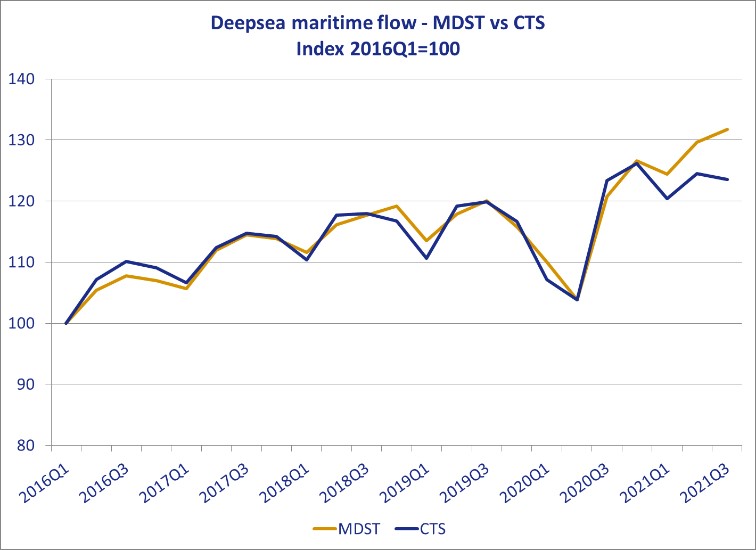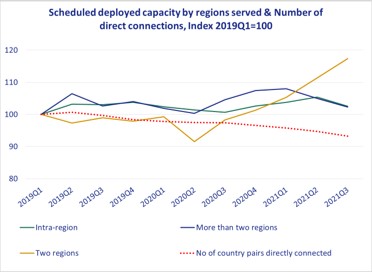Shippers found alternative means of getting their goods to market as available container shipping services maxed out and service patterns changed to serve congested routes.
Global trade continued to grow in Quarter 3 2021 but with deployed container shipping capacity fully utilized, that additional growth was being moved by a mix of air freight, rail services between China and Europe, and own-charter vessels or services provided by non-liner carriers.
Commenting on the findings of the latest Container Shipping Market Quarterly Review, published by the Global Shippers Forum and MDS Transmodal, James Hookham, GSF Director said:
“The Container Shipping Market Review shows the extent to which shippers sought out alternatives, as shipping lines priced themselves out of reach and narrowed the cost difference with offerings from other modes. A measurable share is also accounted for by vessels chartered by shippers for their own goods, or by other non-liner shipping carriers.”

Source: MDS Transmodal, World Cargo Database November 2021 & Container Trades Statistics
Looking to the future, James Hookham continued:
“The Great Shipping Crisis of 2021 has taken many casualties as shippers trapped between record rates and very poor service levels struggled to fulfil delivery deadlines for imports destined for the holiday sales season. Shippers will be watching anxiously to see how quickly these conditions abate in 2022, and whether the use of these alternative services will continue to grow”.
“Shipping lines are attributing the cause of the Crisis to severe congestion in ports and logistics bottlenecks inland. But this means that, as these conditions ease post-peak season and output dips in Chinese New Year, container shipping capacity levels should increase to match shippers’ demand more closely. This recovery in capacity could accelerate if consumers switch spending to services rather than goods, and interest rate hikes and higher energy costs take their toll on discretionary spending”.
New analysis in the Review reveals the extent to which shipping lines have adjusted global service patterns with many more ‘shuttle services’ being introduced at the expense of services making multiple port calls in different regions. This reduces the number of countries with direct connections to their export markets and requires more frequent transfer of loads between services at hub ports, such as Singapore and Colombo.
Mike Garratt, Chairman of MDS Transmodal, said:
“Our review this quarter has examined how alliance members have expanded their role in developing consortia and therefore market shares and the way in which they have addressed operational challenges in modifying route structures. This reduction in services linking multiple world regions has been accompanied by a decline in the number of countries that are directly connected.
“Given the dramatic growth in freight rates and declining service performance it is not surprising to see trade growing more quickly than container volumes on the established lines, as shippers have found other transport solutions; starting own shipping routes, using long-haul rail or air or semi-bulk traffics switching to conventional methods.”

The chart shows the increase in the number of scheduled liner services serving just two regions (gold line) and the decline in services making multiple port calls in more than two regions (Blue line) The number of countries benefitting from direct connections has been in decline of since 2019.
Source: MDS Transmodal, Containership Databank November 2021
Notes to Editors
- Mike Garratt, Chairman of MDS Transmodal, is available for interview. Please contact +44 (0) 1244 348301
- James Hookham, Secretary General of GSF, is available for interview. Please contact: +44 (0) 7818 450440; secretariat@globalshippersforum.com
- Media Contact: The Container Shipping Market Quarterly Review for Quarter 3 2021 is available in PDF format on request from Maria Udy, Portcare International. maria@portcare.com +44 (0) 7979 868539.
- The Container Shipping Market Quarterly Review is produced every three months and reports, interprets and comments on trends and developments in the container shipping market as experienced and understood by shippers – the importers and exporting businesses that own the cargo carried on container ships. Shippers are the customers of the container shipping industry.
- The Review collates and reports outputs from MDS Transmodal’s established and respected Container Business Model and other tools that are relied upon by governments and international agencies around the world. Working with GSF, MDST has generated eight new indicators showing how the market is performing in terns that are relevant and applicable to shippers as users and customers of these services. A copy of the Shippers Dashboard summarising these findings follows these notes.
- MDS Transmodal (MDST, www.mdst.co.uk) is a UK firm of transport economists which specialises in maritime and all other modes of freight transport. MDST works with senior management in the public and private sectors to provide strategic advice based on quantitative analysis, modelling and sectoral expertise.
- Global Shippers Forum (www.globalshippersforum.com) is the global business organisation speaking up for exporters and importers as cargo owners in international supply chains and trade procedures. Its members are national and regional shippers’ associations representing hundreds of manufacturing, wholesaling, and retailing businesses in over 20 countries across five continents. GSF works for safe, competitively efficient, and environmentally sustainable global trade and logistics.






